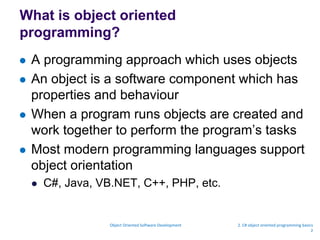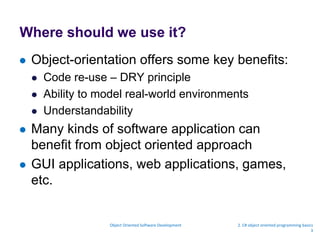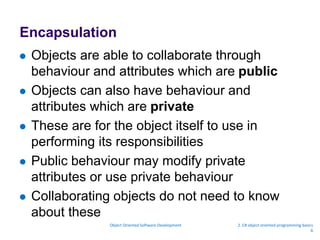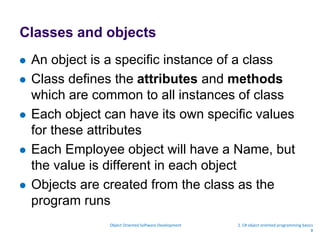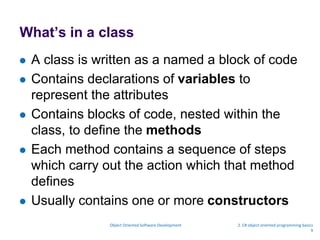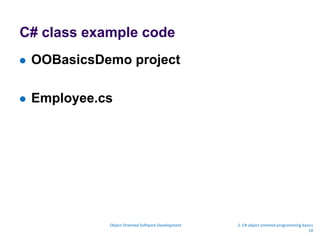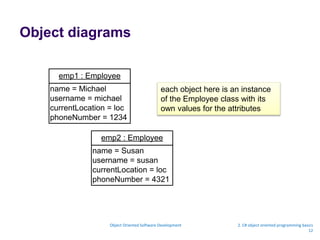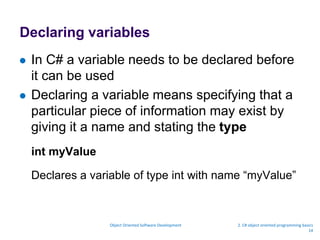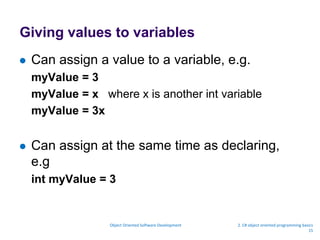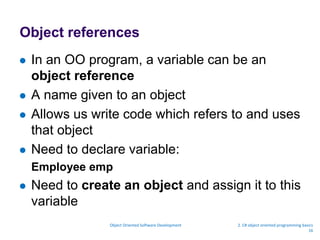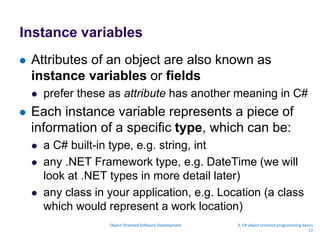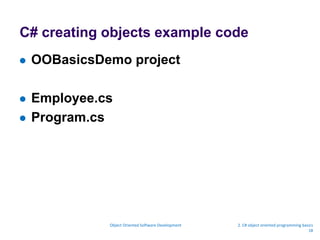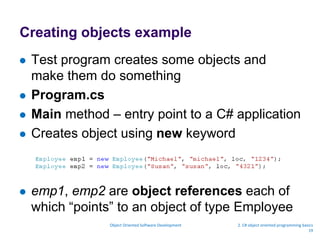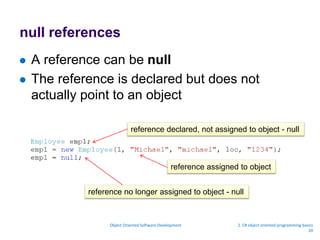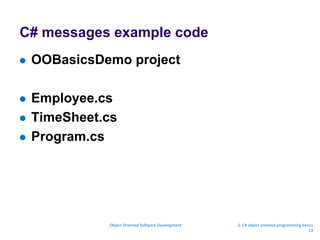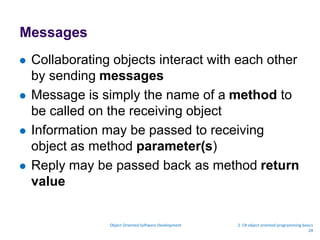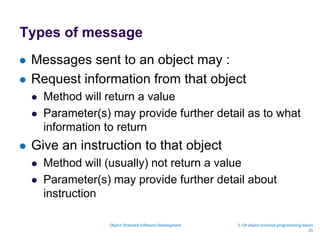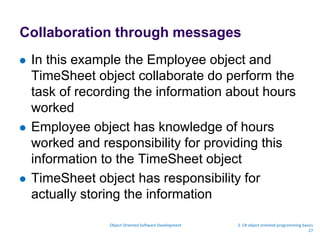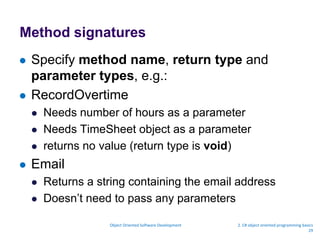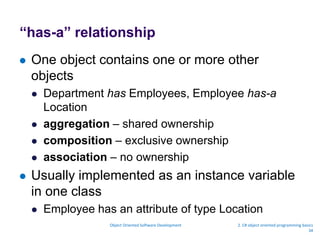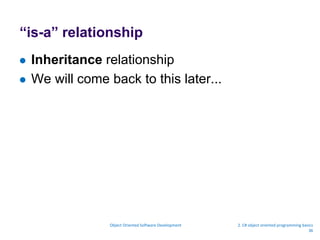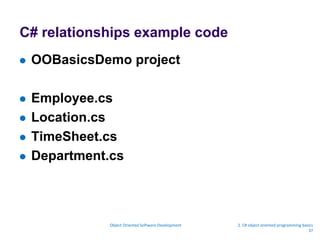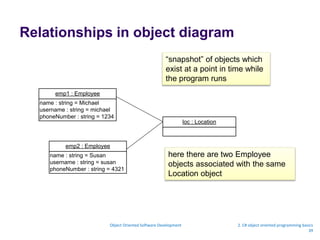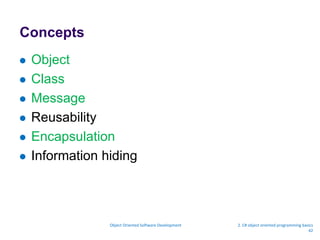Object Oriented Software Development, using c# programming language
- 1. Object Oriented Software Development 2. C# object oriented programming basics
- 2. What is object oriented programming? A programming approach which uses objects An object is a software component which has properties and behaviour When a program runs objects are created and work together to perform the program’s tasks Most modern programming languages support object orientation C#, Java, VB.NET, C++, PHP, etc. Object Oriented Software Development 2. C# object oriented programming basics 2
- 3. Where should we use it? Object-orientation offers some key benefits: Code re-use – DRY principle Ability to model real-world environments Understandability Many kinds of software application can benefit from object oriented approach GUI applications, web applications, games, etc. Object Oriented Software Development 2. C# object oriented programming basics 3
- 4. Objects An entity, or thing, is represented as an object in the program e.g. an object representing an Employee in a company Objects have attributes to represent state of object, e.g. name, location of an Employee Objects have methods to define the actions, or behaviour, which object can perform, e.g. an Employee could record that he or she worked some overtime hours Object Oriented Software Development 2. C# object oriented programming basics 4
- 5. Responsibilities and collaboration Objects have responsibilities This allows objects to interact, or collaborate, with each other Program consists of objects which interact, just as real world entities interact For example, in a real-world company each person has a job to do (responsibilities), and people collaborate to achieve the company’s aims Object Oriented Software Development 2. C# object oriented programming basics 5
- 6. Encapsulation Objects are able to collaborate through behaviour and attributes which are public Objects can also have behaviour and attributes which are private These are for the object itself to use in performing its responsibilities Public behaviour may modify private attributes or use private behaviour Collaborating objects do not need to know about these Object Oriented Software Development 2. C# object oriented programming basics 6
- 7. Classes May have more than one object of the same kind that have common characteristics Class is a template for creating objects of the same kind A bit like a job description for a real-world job Employee class can be used to create many Employee objects When we write the code we are actually writing the class definitions Object Oriented Software Development 2. C# object oriented programming basics 7
- 8. Classes and objects An object is a specific instance of a class Class defines the attributes and methods which are common to all instances of class Each object can have its own specific values for these attributes Each Employee object will have a Name, but the value is different in each object Objects are created from the class as the program runs Object Oriented Software Development 2. C# object oriented programming basics 8
- 9. What’s in a class A class is written as a named a block of code Contains declarations of variables to represent the attributes Contains blocks of code, nested within the class, to define the methods Each method contains a sequence of steps which carry out the action which that method defines Usually contains one or more constructors Object Oriented Software Development 2. C# object oriented programming basics 9
- 10. C# class example code OOBasicsDemo project Employee.cs Object Oriented Software Development 2. C# object oriented programming basics 10
- 11. Class diagrams Object Oriented Software Development 2. C# object oriented programming basics 11 class name attributes methods private – cannot be accessed by other objects public – can be accessed by other objects
- 12. Object diagrams Object Oriented Software Development 2. C# object oriented programming basics 12 name = Michael username = michael currentLocation = loc phoneNumber = 1234 emp1 : Employee name = Susan username = susan currentLocation = loc phoneNumber = 4321 emp2 : Employee each object here is an instance of the Employee class with its own values for the attributes
- 13. Variables A variable is a name given to a piece of information in a program Allows us write code which refers to and uses that information Actual value will depend on what has happened as the program runs May be different each time the program runs and may change as it runs Object Oriented Software Development 2. C# object oriented programming basics 13
- 14. Declaring variables In C# a variable needs to be declared before it can be used Declaring a variable means specifying that a particular piece of information may exist by giving it a name and stating the type int myValue Declares a variable of type int with name “myValue” Object Oriented Software Development 2. C# object oriented programming basics 14
- 15. Giving values to variables Can assign a value to a variable, e.g. myValue = 3 myValue = x where x is another int variable myValue = 3x Can assign at the same time as declaring, e.g int myValue = 3 Object Oriented Software Development 2. C# object oriented programming basics 15
- 16. Object references In an OO program, a variable can be an object reference A name given to an object Allows us write code which refers to and uses that object Need to declare variable: Employee emp Need to create an object and assign it to this variable Object Oriented Software Development 2. C# object oriented programming basics 16
- 17. Instance variables Attributes of an object are also known as instance variables or fields prefer these as attribute has another meaning in C# Each instance variable represents a piece of information of a specific type, which can be: a C# built-in type, e.g. string, int any .NET Framework type, e.g. DateTime (we will look at .NET types in more detail later) any class in your application, e.g. Location (a class which would represent a work location) Object Oriented Software Development 2. C# object oriented programming basics 17
- 18. C# creating objects example code OOBasicsDemo project Employee.cs Program.cs Object Oriented Software Development 2. C# object oriented programming basics 18
- 19. Creating objects example Test program creates some objects and make them do something Program.cs Main method – entry point to a C# application Creates object using new keyword emp1, emp2 are object references each of which “points” to an object of type Employee Object Oriented Software Development 2. C# object oriented programming basics 19
- 20. null references A reference can be null The reference is declared but does not actually point to an object Object Oriented Software Development 2. C# object oriented programming basics 20 reference declared, not assigned to object - null reference assigned to object reference no longer assigned to object - null
- 21. Constructors Constructor is executed when object is created to initialise object Constructor is similar to a method, but must have same name as the class Employee must have constructor with list of parameters which match information supplied Object Oriented Software Development 2. C# object oriented programming basics 21
- 22. Constructors Class can have more than one constructor, each with different parameter list Employee has two constructors – one takes no parameters (default constructor) Object Oriented Software Development 2. C# object oriented programming basics 22
- 23. C# messages example code OOBasicsDemo project Employee.cs TimeSheet.cs Program.cs Object Oriented Software Development 2. C# object oriented programming basics 23
- 24. Messages Collaborating objects interact with each other by sending messages Message is simply the name of a method to be called on the receiving object Information may be passed to receiving object as method parameter(s) Reply may be passed back as method return value Object Oriented Software Development 2. C# object oriented programming basics 24
- 25. Types of message Messages sent to an object may : Request information from that object Method will return a value Parameter(s) may provide further detail as to what information to return Give an instruction to that object Method will (usually) not return a value Parameter(s) may provide further detail about instruction Object Oriented Software Development 2. C# object oriented programming basics 25
- 26. Sending messages to objects Send message by calling method In example code, method of Employee sends message to a TimeSheet object to ask it to add an entry Calls AddEntry method Employee does not need to know how TimeSheet does this Note that test program sends message to Employee object to start this off Object Oriented Software Development 2. C# object oriented programming basics 26
- 27. Collaboration through messages In this example the Employee object and TimeSheet object collaborate do perform the task of recording the information about hours worked Employee object has knowledge of hours worked and responsibility for providing this information to the TimeSheet object TimeSheet object has responsibility for actually storing the information Object Oriented Software Development 2. C# object oriented programming basics 27
- 28. Sequence diagram Object Oriented Software Development 2. C# object oriented programming basics 28 Program emp1 ts RecordOvertime() AddEntry() object message time This diagram shows that Program calls RecordOvertime on Employee object emp1, which as a result calls AddEntry on TimeSheet object ts – look at code to see how this works
- 29. Method signatures Specify method name, return type and parameter types, e.g.: RecordOvertime Needs number of hours as a parameter Needs TimeSheet object as a parameter returns no value (return type is void) Email Returns a string containing the email address Doesn’t need to pass any parameters Object Oriented Software Development 2. C# object oriented programming basics 29
- 30. Class diagram with more detail Object Oriented Software Development 2. C# object oriented programming basics 30 attribute types parameters return type
- 31. Methods and algorithms A method contains code which defines the steps required to perform an action Sometimes this can be very simple: AddEntry method simply writes to console RecordOvertime method just sends a message to another object Sometimes the action is more complicated, and requires many steps to define an algorithm Object Oriented Software Development 2. C# object oriented programming basics 31
- 32. Methods and algorithms Algorithm is a step-by-step procedure to solve a problem Steps are defined as program statements May involve combination of any of the following: Calculations Decisions: if-else statements Repeated actions: for, while loops Calls to other methods Object Oriented Software Development 2. C# object oriented programming basics 32
- 33. Relationships Need to define relationships to allow objects to interact Can show relationships in class and object diagrams Need to implement these in code Learn code patterns for implementing various relationship types Object Oriented Software Development 2. C# object oriented programming basics 33
- 34. “has-a” relationship One object contains one or more other objects Department has Employees, Employee has-a Location aggregation – shared ownership composition – exclusive ownership association – no ownership Usually implemented as an instance variable in one class Employee has an attribute of type Location Object Oriented Software Development 2. C# object oriented programming basics 34
- 35. “uses-a” relationship One object has some kind of association with another Employee uses-a TimeSheet Association is temporary, not implemented by instance variable Can be implemented through a method parameter Employee’s RecordOvertime method has a parameter of type TimeSheet Object Oriented Software Development 2. C# object oriented programming basics 35
- 36. “is-a” relationship Inheritance relationship We will come back to this later... Object Oriented Software Development 2. C# object oriented programming basics 36
- 37. C# relationships example code OOBasicsDemo project Employee.cs Location.cs TimeSheet.cs Department.cs Object Oriented Software Development 2. C# object oriented programming basics 37
- 38. Relationships in class diagram Object Oriented Software Development 2. C# object oriented programming basics 38 aggregation association (has-a) association (uses-a) Note that we are not showing the currentLocation attribute of type Location in the Employee class box now as it is implied by the relationship
- 39. Relationships in object diagram Object Oriented Software Development 2. C# object oriented programming basics 39 name : string = Michael username : string = michael phoneNumber : string = 1234 emp1 : Employee name : string = Susan username : string = susan phoneNumber : string = 4321 emp2 : Employee loc : Location here there are two Employee objects associated with the same Location object “snapshot” of objects which exist at a point in time while the program runs
- 40. Key OO concepts Object Class Message Relationship Object Oriented Software Development 2. C# object oriented programming basics 40
- 41. What’s next? Next we will look in more detail at the syntax of C# and how to write C# classes Object Oriented Software Development 2. C# object oriented programming basics 41
- 42. Concepts Object Class Message Reusability Encapsulation Information hiding Object Oriented Software Development 2. C# object oriented programming basics 42


